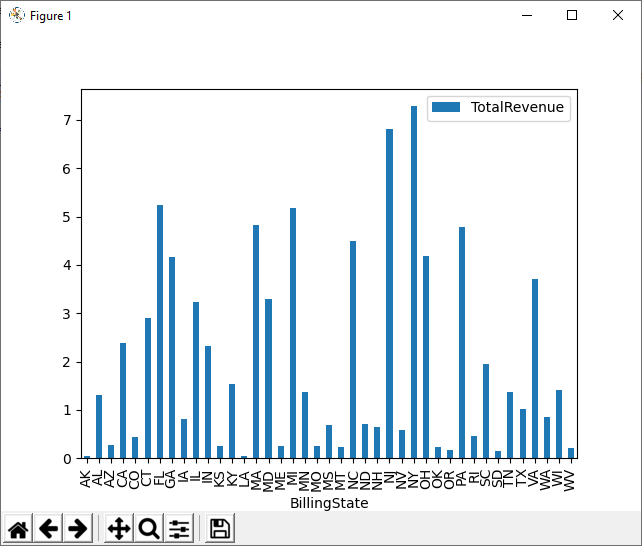Discover how a bimodal integration strategy can address the major data management challenges facing your organization today.
Get the Report →How to Visualize Smartsheet Data in Python with pandas
Use pandas and other modules to analyze and visualize live Smartsheet data in Python.
The rich ecosystem of Python modules lets you get to work quickly and integrate your systems more effectively. With the CData Python Connector for Smartsheet, the pandas & Matplotlib modules, and the SQLAlchemy toolkit, you can build Smartsheet-connected Python applications and scripts for visualizing Smartsheet data. This article shows how to use the pandas, SQLAlchemy, and Matplotlib built-in functions to connect to Smartsheet data, execute queries, and visualize the results.
With built-in optimized data processing, the CData Python Connector offers unmatched performance for interacting with live Smartsheet data in Python. When you issue complex SQL queries from Smartsheet, the driver pushes supported SQL operations, like filters and aggregations, directly to Smartsheet and utilizes the embedded SQL engine to process unsupported operations client-side (often SQL functions and JOIN operations).
About Smartsheet Data Integration
CData provides the easiest way to access and integrate live data from Smartsheet. Customers use CData connectivity to:
- Read and write attachments, columns, comments and discussions.
- View the data in individuals cells, report on cell history, and more.
- Perform Smartsheet-specific actions like deleting or downloading attachments, creating, copying, deleting, or moving sheets, and moving or copying rows to another sheet.
Users frequently integrate Smartsheet with analytics tools such as Tableau, Crystal Reports, and Excel. Others leverage our tools to replicate Smartsheet data to databases or data warehouses.
Getting Started
Connecting to Smartsheet Data
Connecting to Smartsheet data looks just like connecting to any relational data source. Create a connection string using the required connection properties. For this article, you will pass the connection string as a parameter to the create_engine function.
Smartsheet uses the OAuth authentication standard. To authenticate using OAuth, you will need to register an app to obtain the OAuthClientId, OAuthClientSecret, and CallbackURL connection properties.
However, for testing purposes you can instead use the Personal Access Token you get when you create an application; set this to the OAuthAccessToken connection property.
Follow the procedure below to install the required modules and start accessing Smartsheet through Python objects.
Install Required Modules
Use the pip utility to install the pandas & Matplotlib modules and the SQLAlchemy toolkit:
pip install pandas pip install matplotlib pip install sqlalchemy
Be sure to import the module with the following:
import pandas import matplotlib.pyplot as plt from sqlalchemy import create_engine
Visualize Smartsheet Data in Python
You can now connect with a connection string. Use the create_engine function to create an Engine for working with Smartsheet data.
engine = create_engine("smartsheet:///?OAuthClientId=MyOauthClientId&OAuthClientSecret=MyOAuthClientSecret&CallbackURL=http://localhost:33333&InitiateOAuth=GETANDREFRESH&OAuthSettingsLocation=/PATH/TO/OAuthSettings.txt")
Execute SQL to Smartsheet
Use the read_sql function from pandas to execute any SQL statement and store the resultset in a DataFrame.
df = pandas.read_sql("SELECT TaskName, Progress FROM Sheet_Event_Plan_Budget WHERE Assigned = 'Ana Trujilo'", engine)
Visualize Smartsheet Data
With the query results stored in a DataFrame, use the plot function to build a chart to display the Smartsheet data. The show method displays the chart in a new window.
df.plot(kind="bar", x="TaskName", y="Progress") plt.show()

Free Trial & More Information
Download a free, 30-day trial of the CData Python Connector for Smartsheet to start building Python apps and scripts with connectivity to Smartsheet data. Reach out to our Support Team if you have any questions.
Full Source Code
import pandas
import matplotlib.pyplot as plt
from sqlalchemy import create_engin
engine = create_engine("smartsheet:///?OAuthClientId=MyOauthClientId&OAuthClientSecret=MyOAuthClientSecret&CallbackURL=http://localhost:33333&InitiateOAuth=GETANDREFRESH&OAuthSettingsLocation=/PATH/TO/OAuthSettings.txt")
df = pandas.read_sql("SELECT TaskName, Progress FROM Sheet_Event_Plan_Budget WHERE Assigned = 'Ana Trujilo'", engine)
df.plot(kind="bar", x="TaskName", y="Progress")
plt.show()





